What'sNEW Archives, April-June 2005
 27 June 2005
27 June 2005
"Gene duplication is the primary source of new genes." This is the opening sentence of a new sequence analysis by three Italian biologists who describe an evolutionary process in Archeae. It began, they say, with a single gene that codes for an enzyme with two related catalytic functions. After duplication each of the two gene copies specialized in one function and lost the other. Thus in certain species of Archaea, two different, new genes took over the enzymatic activity formerly encoded by a single gene. They call this process of specialization following gene duplication subfunctionalization.
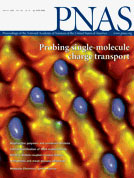 In commentary Austin L. Hughes writes, "Evolutionary biologists agree that gene duplication has played an important role in the history of life on Earth, providing a supply of novel genes that make it possible for organisms to adapt to new environments.... But it is less certain how this panoply of new functions actually arises, leaving room for ingenious speculation but not much rigor. Cases where we can reconstruct with any confidence the evolutionary steps involved in the functional diversification are relatively few. Thus [the subject report]... is particularly welcome as a concrete example of how new protein functions can arise."
In commentary Austin L. Hughes writes, "Evolutionary biologists agree that gene duplication has played an important role in the history of life on Earth, providing a supply of novel genes that make it possible for organisms to adapt to new environments.... But it is less certain how this panoply of new functions actually arises, leaving room for ingenious speculation but not much rigor. Cases where we can reconstruct with any confidence the evolutionary steps involved in the functional diversification are relatively few. Thus [the subject report]... is particularly welcome as a concrete example of how new protein functions can arise."
We have often asked where new genetic programs come from. (Note that the terms, function, protein, gene, and genetic program are not interchangeable. After mentioning "new protein functions," Hughes discusses "New Proteins for Old Functions".) In this analysis, two "new genes" may have been created from one older one, but the genetic programs they contain were already contained in, and lifted whole from, their predecessor gene. Their subsequent optimization is a well-supported darwinian phenomenon. But optimization within a narrow range is very different from the composition of a new program.
In contrast with subfunctionalization, neofunctionalization is the process whereby mutation following duplication would eventually compose a new genetic program. But this process is not well-supported by evidence, as Hughes plainly states. Obviously, he is very pleased by the evidence in this new analysis. But subfunctionalization only explains how an existing gene's different programmatic parts may get parceled out to separate genes and subsequently optimized. As for where new genetic programs come from, darwinian theory still offers only "ingenious speculation."
 20 Oct 2007: New genetic functions arise when selection is imposed on a minor side function of a preexisting gene. 20 Oct 2007: New genetic functions arise when selection is imposed on a minor side function of a preexisting gene.
 Giuseppe D. Tocchini-Valentini et al., "Structure, function, and evolution of the tRNA endonucleases of Archaea: An example of subfunctionalization" [abstract], p 8933-8938 v 102, Proc. Nat. Acad. Sci. USA, 21 Jun 2005. Giuseppe D. Tocchini-Valentini et al., "Structure, function, and evolution of the tRNA endonucleases of Archaea: An example of subfunctionalization" [abstract], p 8933-8938 v 102, Proc. Nat. Acad. Sci. USA, 21 Jun 2005.
 Austin L. Hughes, "Gene duplication and the origin of novel proteins" [extract], p 8971-8972 v 102, Proc. Nat. Acad. Sci. USA, 21 Jun 2005. Austin L. Hughes, "Gene duplication and the origin of novel proteins" [extract], p 8971-8972 v 102, Proc. Nat. Acad. Sci. USA, 21 Jun 2005.
 Viruses and Other Gene Transfer Mechanisms is a CA webpage promoting gene transfer as the source for new genetic programs. [Next-What'sNEW about HGT-Prev] Viruses and Other Gene Transfer Mechanisms is a CA webpage promoting gene transfer as the source for new genetic programs. [Next-What'sNEW about HGT-Prev]
 New genetic programs in Darwinism and strong panspermia is a CA webpage about reconstructing the evolutionary steps involved when new genetic programs are acquired. New genetic programs in Darwinism and strong panspermia is a CA webpage about reconstructing the evolutionary steps involved when new genetic programs are acquired.
 Duplication Makes A New Primate Gene is a related CA webpage. Duplication Makes A New Primate Gene is a related CA webpage.
 24 June 2005
24 June 2005
 Degrees in astrobiology will be offered by the University of Arizona, Tucson. Undergraduate and graduate degrees will grow from UA's Life and Planets Astrobiology Center, which is already affiliated with NASA's virtual Astrobiology Institute. Professor of chemistry and astronomy Lucy Ziurys says, "We'd really like to know if there is life on other planets, but in order to evaluate what we should be looking for, we need to understand how life evolved on Earth." Sounds promising!
Degrees in astrobiology will be offered by the University of Arizona, Tucson. Undergraduate and graduate degrees will grow from UA's Life and Planets Astrobiology Center, which is already affiliated with NASA's virtual Astrobiology Institute. Professor of chemistry and astronomy Lucy Ziurys says, "We'd really like to know if there is life on other planets, but in order to evaluate what we should be looking for, we need to understand how life evolved on Earth." Sounds promising!
 Life and Planets Astrobiology Center, The University of Arizona. Life and Planets Astrobiology Center, The University of Arizona.
 Monica Everett-Haynes, "UA to offer astrobiology degrees soon," Tucson Citizen, 23 Jun 2005. Monica Everett-Haynes, "UA to offer astrobiology degrees soon," Tucson Citizen, 23 Jun 2005.

 22 June 2005 22 June 2005
Two new books about Fred Hoyle are available.
 Simon Mitton, Conflict in the Cosmos: Fred Hoyle's Life in Science, 428 pages, ISBN: 0309093139, Joseph Henry Press, 1 Mar 2005. Simon Mitton, Conflict in the Cosmos: Fred Hoyle's Life in Science, 428 pages, ISBN: 0309093139, Joseph Henry Press, 1 Mar 2005.
 Jane Gregory, Fred Hoyle's Universe, 416 pages, ISBN: 0198507917, Oxford University Press, 26 May 2005. Jane Gregory, Fred Hoyle's Universe, 416 pages, ISBN: 0198507917, Oxford University Press, 26 May 2005.
 David H. DeVorkin, "The Outsider" [review of Conflict...], p 464-464 v 93, American Scientist, September-October 2005. David H. DeVorkin, "The Outsider" [review of Conflict...], p 464-464 v 93, American Scientist, September-October 2005.
 16 Jun 2005: Tim Radford reviews both books in The Guardian, posted here in "Replies". 16 Jun 2005: Tim Radford reviews both books in The Guardian, posted here in "Replies".
 Fred Hoyle is a related CA webpage. Fred Hoyle is a related CA webpage.
 Thanks, Martin Packer, Larry Klaes and Jeff Nesin for mentioning these books and forwarding reviews. Thanks, Martin Packer, Larry Klaes and Jeff Nesin for mentioning these books and forwarding reviews.
 8 June 2005
8 June 2005
Mars' methane not from life? Two geochemists at Dartmouth suggest an alternate source, olivine.
 Methane doesn't necessarily mean life on Mars..., Dartmouth College Press Release, 7 Jun 2005. Methane doesn't necessarily mean life on Mars..., Dartmouth College Press Release, 7 Jun 2005.
 Life on Mars! is a related CA webpage. Life on Mars! is a related CA webpage.
 Thanks, Larry Klaes. Thanks, Larry Klaes.
 8 June 2005
8 June 2005
NASA and LITU — Recent elaborations on two astrobiology research programs:
 Driving on the Roadmap re: Astrobiology at NASA, from Astrobiology Magazine, 5 Jun 2005. Driving on the Roadmap re: Astrobiology at NASA, from Astrobiology Magazine, 5 Jun 2005.
 The Center for the Study of Life in the Universe, by SETI's Frank Drake, Space.com, 2 Jun 2005. The Center for the Study of Life in the Universe, by SETI's Frank Drake, Space.com, 2 Jun 2005.
 Introduction... is a related CA webpage. Introduction... is a related CA webpage.
 6 June 2005 6 June 2005
...A Third Alternative — This essay, published in 2003, is now available on this website:
 Creationism versus Darwinism: A Third Alternative by Brig Klyce and Chandra Wickramasinghe, p 543-548, Darwinism, Design, and Public Education, John Angus Campbell and Stephen C. Meyer, eds., ISBN 0-87013-675-5, Michigan State University Press, 2003. Also available as a PDF: 776 KB. Creationism versus Darwinism: A Third Alternative by Brig Klyce and Chandra Wickramasinghe, p 543-548, Darwinism, Design, and Public Education, John Angus Campbell and Stephen C. Meyer, eds., ISBN 0-87013-675-5, Michigan State University Press, 2003. Also available as a PDF: 776 KB.

 21 May 2005
21 May 2005
The key to early eye evolution? That's what Nature thinks about the eyes of a jellyfish studied by an interdisciplinary team at Lund University, Sweden. Among the jellyfish's 24 tiny eyes, the eight larger ones have "all the major components of a typical camera-type eye," and the lenses even have refractive index gradients. The lenses of the four upper eyes are capable of "well-corrected, aberration-free imaging, otherwise known only from the much larger eyes of vertebrates and cephalopods.... The gradient of the upper-eye lenses comes very close to the ideal solution."
However, "The sharp image falls well below the retina, and it would seem that the sharp focus of the lenses is wasted by inappropriate eye geometry.... The visual resolution is thus very much worse than the sophisticated lenses would allow." And unlike other animals with camera-type eyes, the jellyfish has no brain for processing sharp images.
 The Swedish team writes, "This demonstrates that even simple animals have been able to evolve the sophisticated visual optics previously known only to advanced bilaterian phyla." In support of this assertion they mention that the jellyfish's lens crystallins are unrelated to those of other species, according to a 1993 analysis. But a program's unrelatedness does not provide evidentiary support for its de novo darwinian evolution, as customarily assumed. Plausible genetic evidence for stepwise construction of the new genetic program would be needed for that. Besides, why would the jellyfish need such advanced optics? How would natural selection produce excellent, virtually useless lenses? Without a visual cortex, could the jellyfish somehow perform complex visual processing in its retina? Or perhaps, as the Swedes ultimately suppose, "There might be visual tasks best served by a blurred image." How would that call for a sharp lens?
The Swedish team writes, "This demonstrates that even simple animals have been able to evolve the sophisticated visual optics previously known only to advanced bilaterian phyla." In support of this assertion they mention that the jellyfish's lens crystallins are unrelated to those of other species, according to a 1993 analysis. But a program's unrelatedness does not provide evidentiary support for its de novo darwinian evolution, as customarily assumed. Plausible genetic evidence for stepwise construction of the new genetic program would be needed for that. Besides, why would the jellyfish need such advanced optics? How would natural selection produce excellent, virtually useless lenses? Without a visual cortex, could the jellyfish somehow perform complex visual processing in its retina? Or perhaps, as the Swedes ultimately suppose, "There might be visual tasks best served by a blurred image." How would that call for a sharp lens?
We are impressed by the depth of this research, but we find the initial darwinian account of the phenomenon weak, to say the least. Rather than providing a "missing link," as Nature suggests, the jellyfish eyes are another surprise for darwinism. Conversely, programs that seem to "come from nowhere" are a standard phenomenon in cosmic ancestry. And if new genetic programs are acquired by gene transfer, they might occasionally be more powerful than necessary, as it seems here. We hope the jellyfish eyes will be further analysed from a genomics perspective. Meanwhile, we hope people will notice how this discovery relates to darwinism — it is not a missing piece of that puzzle, but yet another puzzle.
 Dan-E. Nillson et al., "Advanced optics in a jellyfish eye" [abstract], p 201-205 v 435, Nature, 12 May 2005. Dan-E. Nillson et al., "Advanced optics in a jellyfish eye" [abstract], p 201-205 v 435, Nature, 12 May 2005.
 Rüdiger Wehner, "Missing link?" [summary], p 157-159 v 435, Nature, 12 May 2005. Rüdiger Wehner, "Missing link?" [summary], p 157-159 v 435, Nature, 12 May 2005.
 Neo-Darwinism... is a related CA webpage with a discussion of eyes under Coordinating Genes. Neo-Darwinism... is a related CA webpage with a discussion of eyes under Coordinating Genes.

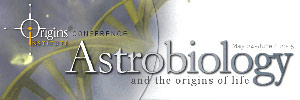 16 May 2005 16 May 2005
The Origins Institute at McMaster University will conduct an Astrobiology Conference, 24-28 May 2005, with a smaller workshop to follow, 30 May - 4 June 2005. The newly formed Institute is organizing the conference and workshop around two themes, Planetary Science and Evolutionary Biology.
 Origins Institute Conference, McMaster University, Hamilton, Ontario, Canada, 24-28 May 2005. Origins Institute Conference, McMaster University, Hamilton, Ontario, Canada, 24-28 May 2005.
 Thanks, John Parnell. Thanks, John Parnell.
 16 May 2005
16 May 2005
Jumping genes may be a headache for researchers, but they serve an important ecological purpose, helping other organisms to succeed in their habitats — Carrine Blank, Washington University, St. Louis

 Map of life on Earth could be used on Mars, by Alison Drain, WUSTL, 9 May 2005. Map of life on Earth could be used on Mars, by Alison Drain, WUSTL, 9 May 2005.
 Viruses and Other Gene Transfer Mechanisms is a related CA webpage. Viruses and Other Gene Transfer Mechanisms is a related CA webpage.

 12 May 2005
12 May 2005
Somewhere, something incredible is waiting to be known — Carl Sagan (1934-1996)
 Thanks, Space.com. Thanks, Space.com.
 5 May 2005
5 May 2005
A report on the NASA Astrobiology Institute Conference held in Boulder, Colorado, 10-14 April 2005, written by Senior Scientist David Morrison, is available on the Internet.

 The 2005 General Meeting of the NASA Astrobiology Institute, NASA, 2005. The 2005 General Meeting of the NASA Astrobiology Institute, NASA, 2005.
 Thanks, Marsbugs. Thanks, Marsbugs.
 2 May 2005
2 May 2005
Lithopanspermia in star-forming clusters would be more probable than independent origin-of-life on terrestrial planets, according to a mathematical analysis by astrophysicists from the University of Michigan and Princeton University.
 Fred C. Adams and David N. Spergel, "Lithopanspermia in Star Forming Clusters," [abstract], e-Print Archive: astro-ph/0504648, Apr 2005. Fred C. Adams and David N. Spergel, "Lithopanspermia in Star Forming Clusters," [abstract], e-Print Archive: astro-ph/0504648, Apr 2005.
 Did Life Arrive Before the Solar System Even Formed?, commentary by Jeff Barbour, Universe Today, 4 May 2005. Did Life Arrive Before the Solar System Even Formed?, commentary by Jeff Barbour, Universe Today, 4 May 2005.
 Thanks, Larry Klaes. Thanks, Larry Klaes.
  29 Apr 2005
29 Apr 2005
The 5th European Workshop on Astrobiology, sponsored by the European Astrobiology Network Asociation (EANA), will be held in Budapest, 10-12 October 2005.
 5th European Workshop on Astrobiology, Budapest, Hungary, 10-12 Oct 2005. 5th European Workshop on Astrobiology, Budapest, Hungary, 10-12 Oct 2005.
 Thanks, Mark J. Burchell. Thanks, Mark J. Burchell.

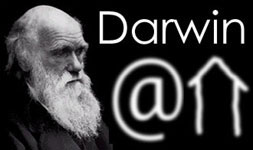 29 Apr 2005
29 Apr 2005
Darwin-at-Home is launched as "a planetwide effort to create networked digital ecosystems. D@H teams strive toward an elusive goal: to observe lifelike evolutionary processes in virtual or robotic space. D@H platforms run distributed across a large pool of networked computers...," in the style of SETI@Home. We welcome this imaginative new attempt to find a computer model that can do what darwinian evolution claims for biology. Computer models are already able to mimic a number of darwinian phenomena, including artificial selection, natural selection, speciation, variation, and optimization. Computers are also adept at puzzle-solving, or assembling fragmented parts for performing a certain function. We believe that genomes must also use puzzle-solving for assembling genetic programs acquired in pieces by gene transfer. However, computer models have not demonstrated the ability to invent new programs without teleology and without an obvious limit. If they can do this, the most controversial claim of darwinism will have been demonstrated in principle. But until this capability is demonstrated in closed experiments in computers or biology, there is reason to doubt that it is possible. If it is not possible, as we suspect, genetic input from elsewhere would be needed. We will watch for future developments.
 Darwin@Home, by Biota.org. Darwin@Home, by Biota.org.
 Is Sustained Macroevolutionary Progress Possible? is one of several CA webpages calling for closed-system demonstrations. Is Sustained Macroevolutionary Progress Possible? is one of several CA webpages calling for closed-system demonstrations.
 Thanks, Bruce Damer. Thanks, Bruce Damer.


Three views of Titan |
26 Apr 2005
Organics in Titan's high atmosphere were seen by instruments aboard Cassini during its closest flyby, 16 April. "Biology on Earth is the primary source of organic production we are familiar with...," said Dr. Hunter Waite, principal investigator of the Cassini ion and neutral mass spectrometer. Could biology also be the source of Titan's organics?
 Organic Materials Spotted High Above Titan's Surface, NASA, JPL, 25 Apr 2005. Organic Materials Spotted High Above Titan's Surface, NASA, JPL, 25 Apr 2005.
 Organically-Certified Titan, Astrobiology Magazine, 26 Apr 2005. Organically-Certified Titan, Astrobiology Magazine, 26 Apr 2005.
 Life on Europa or Other Moons? has related links. Life on Europa or Other Moons? has related links.

 24 Apr 2005
24 Apr 2005
Information Theory, Evolution and the Origin of Life — Hubert Yockey has long studied life's programming from the perspective of information theory. His sceptical conclusions about origin-of-life theories are often cited by proponents of creationism / intelligent design (ID). But in his new book, Yockey is sceptical about some of their theories, too. For example, against Michael Behe, Yockey says that protein sequences cannot be irreducibly complex (p 179).
Regarding ID he comments that, according to information theory, "Once life has appeared,... genetic messages will not fade away and can indeed survive for 3.85 billion years without assistance from an Intelligent Designer" (p 181, 184). Okay, but the most interesting aspect of evolution is not the survival of old genetic programs, but the apparent invention of new ones. Does information theory explain how new genetic programs might be composed de novo? Can the process be observed or modeled? An informed discussion of this issue is sorely needed. Yockey's silence about it surprises and disappoints us.
As he ranges widely through the history of evolutionary theory, Yockey often wants to set the record straight. Specifically, several theories and experiments were known already, before the scientists who got credit for them came along. Furthermore, "Darwin did not believe in a 'warm little pond'..." (p 120), and "Oparin was very close to Lysenko" (p 153). If you are interested in information theory and biology, you will probably be edified by Yockey's scholarship in this book.
 Hubert P. Yockey, Information Theory, Evolution and the Origin of Life, Cambridge University Press, 2005. Hubert P. Yockey, Information Theory, Evolution and the Origin of Life, Cambridge University Press, 2005.
 Evolution versus Creationism is a related CA webpage. Evolution versus Creationism is a related CA webpage.
 The Second Law of Thermodynamics reviews an earlier writing by Yockey. The Second Law of Thermodynamics reviews an earlier writing by Yockey.
 Computer Models of Evolution and the four "Next" pages are related to Yockey's topic. Computer Models of Evolution and the four "Next" pages are related to Yockey's topic.
 Correspondence with Hubert Yockey, 17-19 May 2005. Correspondence with Hubert Yockey, 17-19 May 2005.
 Correspondence with Cynthia
Yockey, 17 Nov 2005. Correspondence with Cynthia
Yockey, 17 Nov 2005.

 22 Apr 2005 22 Apr 2005
Today, we still do not fully understand how life began on our planet, although there is optimism that this will change in the near future (2).
 Jeffrey Bada, "Response" p 496-497 v 308, Science, 22 April 2005.
Jeffrey L. Bada is the Director of the NASA Specialized Center of Research and Training (NSCORT) in Exobiology at the Scripps Institution of Oceanography. Wondering how soon we might "fully understand how life began on our planet," we carefully read reference (2), Bada's own 15-page article of 2004, "How life began on Earth: a status report". He has long believed (with many others) that life began here in a prebiotic soup, and (with fewer others) that the soup was cold. In last year's paper he adds some technical suggestions about the chemistry and lobbies again for the cold scenario. Jeffrey Bada, "Response" p 496-497 v 308, Science, 22 April 2005.
Jeffrey L. Bada is the Director of the NASA Specialized Center of Research and Training (NSCORT) in Exobiology at the Scripps Institution of Oceanography. Wondering how soon we might "fully understand how life began on our planet," we carefully read reference (2), Bada's own 15-page article of 2004, "How life began on Earth: a status report". He has long believed (with many others) that life began here in a prebiotic soup, and (with fewer others) that the soup was cold. In last year's paper he adds some technical suggestions about the chemistry and lobbies again for the cold scenario.
Bada acknowledges that the origin-of-life problem has both a hardware and a software aspect. "Life as we know it as based on chemistry and information," he writes. Yet his speculations are confined to the former. And even on his chosen front, we see no reason for Bada to be optimistic. The latest suggestions leave the main unsolved hardware issues as formidable as ever. Meanwhile, the neglected software problem is even more difficult. Research in this area seems to have stalled completely.
Under the circumstances, we think it is appropriate to reexamine the assumption that life ever originated. Besides the big bang, what evidence do we have that life can originate? This question is entirely scientific; ignoring it is not.
 Jeffrey Bada, "How life began on Earth: a status report" [pdf], doi:10.1016/j.epsl.2004.07.036, p 1-15 v 226, Earth and Planetary Science Letters, 30 Sep 2004. Jeffrey Bada, "How life began on Earth: a status report" [pdf], doi:10.1016/j.epsl.2004.07.036, p 1-15 v 226, Earth and Planetary Science Letters, 30 Sep 2004.
 The RNA World is the main CA webpage about the origin-of-life problem. The RNA World is the main CA webpage about the origin-of-life problem.
 The End and the Big Bang is a related CA webpage. The End and the Big Bang is a related CA webpage.
 The Beginning has more about life without an origin. The Beginning has more about life without an origin.
 20 Apr 2005
20 Apr 2005
The only thing we know of that creates mixtures like that is biology — David Grinspoon, referring to Saturn's moon Titan, whose atmosphere includes methane and probably carbon dioxide; speaking at the NASA Astrobiology Institute conference, 14 April 2005.
 Todd Neff, "Life may be possible on Saturn moon" [text: registration required], The Daily Camera, Boulder CO, 15 Apr 2005. Todd Neff, "Life may be possible on Saturn moon" [text: registration required], The Daily Camera, Boulder CO, 15 Apr 2005.
 Gaia is a related CA webpage. Gaia is a related CA webpage.
 Life on Europa or Other Moons? has related links. Life on Europa or Other Moons? has related links.
 Thanks, Larry Klaes. Thanks, Larry Klaes.

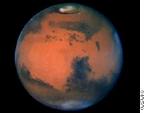 19 Apr 2005
19 Apr 2005
Methane may come from life on Mars, according to Michael Mumma of the Center for Astrobiology at the NASA Goddard Space Flight Center. New information pertaining to Mars' methane comes from NASA's Infrared Telescope Facility (IRTF) in Hawaii, and the Gemini South telescope in the Chilean Andes. Mumma explained the case during the Biennial Meeting of the NASA Astrobiology Institute at the University of Colorado, Boulder, 10-14 April.
 ...Mars Could be Biologically Alive, by Lenard David, Space.com, 19 Apr 2005. ...Mars Could be Biologically Alive, by Lenard David, Space.com, 19 Apr 2005.
 Life on Mars! has links to earlier stories about methane and life on Mars under What'sNEW there. Life on Mars! has links to earlier stories about methane and life on Mars under What'sNEW there.

 18 Apr 2005
18 Apr 2005
Astrobiology in Scotland, a one-day conference, "aims to act as a catalyst to stimulate collaborative, inter-disciplinary research and discuss creation of an Astrobiology Research Group in Scotland and a Scotland-wide graduate level course that would extend across the disciplines that are relevant to Astrobiology by utilising the Scottish Universities Physics Alliance (SUPA) telepresence infrastructure as part of the SUPA graduate school curriculum." Topics include "the search for habitable planets, extra-solar planets, extremophiles, origin of life and early evolution of life on Earth." Conference organizers are John Parnell, Keith Horne and Tony Prave; scheduled keynote speakers are meteoriticist Monica Grady and cosmologist Mario Livio. The conference will be held at the Gateway Centre at the University of St Andrews, Friday, 27 May 2005.
 download Registration Form (pdf), Astrobiology in Scotland Meeting, 27 May 2005. download Registration Form (pdf), Astrobiology in Scotland Meeting, 27 May 2005.
 email Conference Administrator Mr Richard Batchelor (rab@st-andrews.ac.uk) for additional information. email Conference Administrator Mr Richard Batchelor (rab@st-andrews.ac.uk) for additional information.

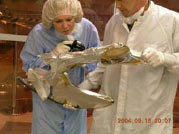 11 Apr 2005
11 Apr 2005
There's an unexplained brown stain in the Genesis science canister. It is clearly visible on the interior anodized aluminum components, but not significantly on the collector. The stain is 160 angstroms thick in places, containing 70% carbon, 1.8-3.5% nitrogen, 17-20% oxygen, and about 4% each of flourine and silicon. The canisters were very carefully prepared to prevent contamination before launch, but contamination is now being reconsidered as the source of the stain. Could it be organic material encountered in space? NASA launched Genesis on 8 August 2001, to collect solar wind particles for 884 days. The capsule containing the collectors was damaged when its parachute failed to deploy over the Utah desert on 8 September 2004. In spite of the damage, much is being learned from the mission.
 D.S. Burnett et al., "Molecular Contamination on Anodized Aluminum Components of the Genesis Science Canister" [PDF #2045], Lunar and Planetary Science XXXVI (Proceedings of the LPS Conference), 14-18 Mar 2005. D.S. Burnett et al., "Molecular Contamination on Anodized Aluminum Components of the Genesis Science Canister" [PDF #2045], Lunar and Planetary Science XXXVI (Proceedings of the LPS Conference), 14-18 Mar 2005.
 Picking Up Where the Genesis Mission Left Off, by Leonard David, Space.com, 30 Mar 2005. Picking Up Where the Genesis Mission Left Off, by Leonard David, Space.com, 30 Mar 2005.
 Genesis Mission Homepage at JPL, NASA. Genesis Mission Homepage at JPL, NASA.
 Comets... is a related CA webpage. Comets... is a related CA webpage.

 5 Apr 2005
5 Apr 2005
Chandra Wickramasinghe's scientific autobiography is titled A Journey with Fred Hoyle. To understand how Hoyle and Wickramasinghe came to endorse panspermia, one can't do better. Although we are familiar with the story, we were still fascinated by this account of their careful study of interstellar dust. For years Fred and Chandra worked to identify a model that would match the dust's extinction spectrum for the broadest range of frequencies. When a model with freeze-dried bacteria produced a near-perfect match in 1979, they bravely published it. That work has been harshly criticised, but competing nonbiological models do not match the observed spectra nearly as well. People barely acquainted with panspermia would gain a surprising, new perspective from this story. Chandra also discusses their research on related topics like the spread of influenza, evolution, microbial fossils in meteorites, and comet Halley. He admits regret over some choices, such as challenging the authenticity of a fossil at the British Museum, or testifying in an Arkansas lawsuit over the science curriculum in public schools. The personal anecdotes are especially enjoyable; once he and Fred were saved from ignomy by Chandra's beautiful and talented wife, Priya. Chandra concludes, "I would gladly follow the same path again."
 Chandra Wickramasinghe, A Journey with Fred Hoyle: The search for cosmic life, [publisher's promo], 240 pages, ISBN 981-238-912-1, World Scientific Publishing Co. Pte. Ltd., Jan 2005. Chandra Wickramasinghe, A Journey with Fred Hoyle: The search for cosmic life, [publisher's promo], 240 pages, ISBN 981-238-912-1, World Scientific Publishing Co. Pte. Ltd., Jan 2005.
 Our Journey to the STARS (review), RedNova, 10 May 2005. Our Journey to the STARS (review), RedNova, 10 May 2005.
 Introduction... is a related CA webpage. Introduction... is a related CA webpage.
 Chandra Wickramasinghe... contains Chandra's opening statement at the Arkansas trial. Chandra Wickramasinghe... contains Chandra's opening statement at the Arkansas trial.
|
 27 June 2005
27 June 2005 In commentary Austin L. Hughes writes, "Evolutionary biologists agree that gene duplication has played an important role in the history of life on Earth, providing a supply of novel genes that make it possible for organisms to adapt to new environments.... But it is less certain how this panoply of new functions actually arises, leaving room for ingenious speculation but not much rigor. Cases where we can reconstruct with any confidence the evolutionary steps involved in the functional diversification are relatively few. Thus [the subject report]... is particularly welcome as a concrete example of how new protein functions can arise."
In commentary Austin L. Hughes writes, "Evolutionary biologists agree that gene duplication has played an important role in the history of life on Earth, providing a supply of novel genes that make it possible for organisms to adapt to new environments.... But it is less certain how this panoply of new functions actually arises, leaving room for ingenious speculation but not much rigor. Cases where we can reconstruct with any confidence the evolutionary steps involved in the functional diversification are relatively few. Thus [the subject report]... is particularly welcome as a concrete example of how new protein functions can arise." Degrees in astrobiology will be offered by the University of Arizona, Tucson. Undergraduate and graduate degrees will grow from UA's Life and Planets Astrobiology Center, which is already affiliated with NASA's virtual Astrobiology Institute. Professor of chemistry and astronomy Lucy Ziurys says, "We'd really like to know if there is life on other planets, but in order to evaluate what we should be looking for, we need to understand how life evolved on Earth." Sounds promising!
Degrees in astrobiology will be offered by the University of Arizona, Tucson. Undergraduate and graduate degrees will grow from UA's Life and Planets Astrobiology Center, which is already affiliated with NASA's virtual Astrobiology Institute. Professor of chemistry and astronomy Lucy Ziurys says, "We'd really like to know if there is life on other planets, but in order to evaluate what we should be looking for, we need to understand how life evolved on Earth." Sounds promising! 22 June 2005
22 June 2005 21 May 2005
21 May 2005 The Swedish team writes, "This demonstrates that even simple animals have been able to evolve the sophisticated visual optics previously known only to advanced bilaterian phyla." In support of this assertion they mention that the jellyfish's lens crystallins are unrelated to those of other species, according to a 1993 analysis. But a program's unrelatedness does not provide evidentiary support for its de novo darwinian evolution, as customarily assumed. Plausible genetic evidence for stepwise construction of the new genetic program would be needed for that. Besides, why would the jellyfish need such advanced optics? How would natural selection produce excellent, virtually useless lenses? Without a visual cortex, could the jellyfish somehow perform complex visual processing in its retina? Or perhaps, as the Swedes ultimately suppose, "There might be visual tasks best served by a blurred image." How would that call for a sharp lens?
The Swedish team writes, "This demonstrates that even simple animals have been able to evolve the sophisticated visual optics previously known only to advanced bilaterian phyla." In support of this assertion they mention that the jellyfish's lens crystallins are unrelated to those of other species, according to a 1993 analysis. But a program's unrelatedness does not provide evidentiary support for its de novo darwinian evolution, as customarily assumed. Plausible genetic evidence for stepwise construction of the new genetic program would be needed for that. Besides, why would the jellyfish need such advanced optics? How would natural selection produce excellent, virtually useless lenses? Without a visual cortex, could the jellyfish somehow perform complex visual processing in its retina? Or perhaps, as the Swedes ultimately suppose, "There might be visual tasks best served by a blurred image." How would that call for a sharp lens?
 16 May 2005
16 May 2005
 29 Apr 2005
29 Apr 2005 29 Apr 2005
29 Apr 2005
 24 Apr 2005
24 Apr 2005
 19 Apr 2005
19 Apr 2005 18 Apr 2005
18 Apr 2005 11 Apr 2005
11 Apr 2005 5 Apr 2005
5 Apr 2005